Natalie Grueninger and Sarah Morris chat about Tudor palaces and historic sites.
Listen using the above player or read the transcript below. Talking Tudors is also available on iTunes. If you’ve enjoyed the episode, please leave a review on iTunes.
Hello and welcome to Talking Tudors, a fortnightly podcast about the ever-fascinating Tudor dynasty. My name is Natalie Grueninger and I’ll be your host and guide on this journey through sixteenth-century England. Are you ready to step through the veil of time into the dazzling and dangerous world of the Tudor court? Without further ado. It’s time to talk Tudors.
(Music break)
Hello everyone, welcome to Talking Tudors, episode one. I’m your host, Natalie Grueninger, and joining me today to talk about Tudor palaces and historic sites is author Sarah Morris.
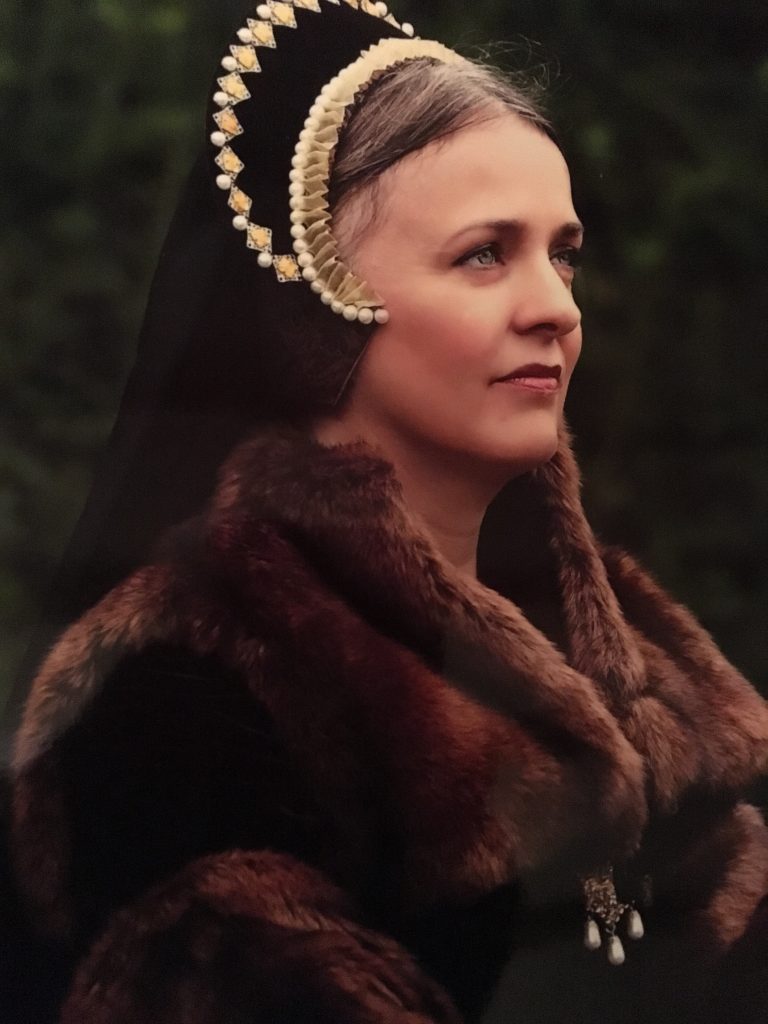
Sarah Morris is an historical researcher, author and blogger. Her books include ‘Le Temps Viendra: a Novel of Anne Boleyn’, ‘In the Footsteps of Anne Boleyn’ and ‘In the Footsteps of the Six Wives of Henry VIII’. Online she is known as ‘The Tudor Travel Guide‘. Her blog (of the same name) is the intimate visitor’s companion to discovering Tudor England. Sarah loves researching and writing about places associated with the Tudor era, so that her followers never leave a Tudor location again thinking, ‘if only I’d known about..!’ Greatest Tudor loves: Anne Boleyn; reading original Tudor documents and writing about lost Tudor buildings
Definitely a woman after my own heart…
Natalie: Welcome to Talking Tudors Sarah! How are you?
Sarah: I’m very well. Thank you for having me. I’m very honoured to be here.
Natalie: Oh, thank you. Now, you and I know each other well, but would you mind telling our listeners a little bit about yourself and your background?
Sarah: Yes, of course. Actually, I’ve got a little bit of a strange background that is not initially to do with history, that comes a little later. But anyway, so believe it or not, I started my career as a medical doctor, although sadly the demands of the job caused me to almost be burnt out after a few years. I left medicine and I worked in the commercial world for a few years and then finally I began to follow my other passion, which is a lifelong passion for personal development. I’d say I’m a pretty curious soul, and enquiry and growth, and I know you’re the same, Nat…
Natalie: Yes, we’re very similar, aren’t we us two?
Sarah: Two peas in a pod, actually. Yeah, so kind of growth and personal growth is a bit like the air that I breathe for me. It’s just part and parcel of who I am, so that passion led me into being a… my current career, which I call my main job, which is as a coach and I’ve been working for the last 15 years running my own business as a leadership and organisational development coach and consultant. So, no history…
Natalie: No history yet…
Sarah: What happened? Well, I suppose 2010 was probably the key year for me. Until that point my kind of love of history had been very much a private affair, to be enjoyed from the comfort of my own sofa with a good history book, or weekend trips away to enjoy and see historic properties and that is something that I’ve certainly been doing since I was knee high to a grasshopper. And then in 2010, my first book, Le Temps Viendra: A Novel of Anne Boleyn sort of happened to me (and I use that phrase quite deliberately), I wasn’t planning on writing it at all and that’s when things changed.
Natalie: Yes, definitely, and so what was it exactly then that sparked your interest in Tudor history do you think. What made you get off the couch and change from a private history lover to a more public sort of passion, I suppose?
Sarah: Yeah, so I thought about this often and I suppose I have my parents to thank really for my deep love of history. As I just mentioned, we spent as a child, we spent most of my weekends and holidays going around stately homes and castles and I think it probably could have gone one of two ways – I either would have rebelled and refused to set foot across the threshold of any historic property again (laughing), or it would get under my skin and I’d be hooked for life. I think fortunately, it turned out to be the latter. Then of course learning about The Tudors in secondary school, here in England, really kind of honed my love and some might call it obsession with Anne Boleyn and then of the Tudor period in general but as I said it was really the kind of writing or the beginning of writing of ‘Le Temps Viendra’ in 2010 that just submerged me deeply in the Tudor world and I began to go online, as I started to research about the book and researching contemporary stuff, making contacts in the Tudor community with people exactly like yourself, Nat.
Natalie: Yes, I was just thinking. I’m pretty sure it was 2010 that we met. I think that I messaged you on Twitter because I saw your profile that said you were writing a novel about Anne Boleyn and I had been running On the Tudor Trail for about a year then and I remember thinking, oh wow, this sounds so interesting and I reached out to you and the rest is history (laughing).
Sarah: The rest is history. I think I’d been stalking you silently a little bit on the internet before then but yes, it was, umm, the rest is certainly history. So really that’s what got me going.
Natalie: Now I know that over the last decade, you’ve spent a lot of time researching and writing about places associated with the Tudors. What do you think inspired you to tell the story of the Tudors through this particular lens?
Sarah: I have to touch back on this thing about visiting ancient castles and ruins and you and I have discussed many times, there is no doubt that whilst the people have come and gone, their lives, their tastes, all the events etc. the buildings themselves still survive and they’re like… they’re physical reminders, physical connections with the past and those people. I think if the circumstances are right, I really feel that there’s sometimes this felt sense of the past and that really helps me to bring the events and the people alive in my imagination. That was something that I lent heavily into as I was writing Le Temps Viendra, when I really needed to kind of get really deeply into the feel of Anne Boleyn, into her mind and soul and yeah, so I think it was doing that that really made me realise how important places are and that’s what really caused me to focus down and start to work with you on writing the In the footsteps books.
Natalie: Absolutely, and we’ve been really lucky to have gone on many historical adventures together. We’ve walked in the footsteps of all the prominent personalities of the day and when we talk about locations after we’ve visited, we often talk about a place’s “historical vibe”. Could you explain to our listeners what this vibe actually is that we’re referring to?
Sarah: Yes, I’m smiling…
Natalie: I’ve got a big smile on my face too…
Sarah: Because I know there are many times when we’ve gone on these shared visits together that you and I have looked knowingly at each other and I know what that look means. It means it’s got the vibe, Sarah, and as far as I can remember, we pretty much always felt the same about the place – you know it sort of has the vibe or it doesn’t.
So, what does that mean? So, as I said for me I think it’s this felt sense of an energy or of people or events and it’s almost like that energy is imprinted in the bricks and the mortar of a place. But what I find really funny is that you actually can’t predict whether it’s going to be there or not. I don’t know about you but certainly for me it’s not to do with the size or the grandeur of the place. You know there’s been many times where, you know, I visited houses that are fully intact and furnished with lots of Tudor stuff and I can feel nothing. I mean it’s beautiful but I don’t feel it and then other times I could wander across an field with a few earthworks or you know, ruins of an old abbey and it’s just singing to me, so it’s mysterious, isn’t it? Mysterious forces that are in play and I’ve got absolutely no way of explaining it but it’s definitely a phenomenon and I’m sure that some of your listeners out there, if not most of them, will have felt this for themselves if they’ve visited these places.
Natalie: Absolutely, I agree with you that there’s a sort of mystery about these places and this might be a good time to confess that we like to caress ancient walls, Sarah! (Laughing)
Sarah: Oh, how could you out me in this way, Natalie! (Laughing)

Natalie: Sometimes even we’ve been known to kiss the wall! (More laughing) But we’ll leave that until a little bit later…
So, in your opinion, Sarah, and I know that this is such a hard question because people ask me this all the time and it’s like sort of picking your favourite child, which is impossible but what are 5 must-see Tudor sites and why? If you could take us through that briefly. What are the top 5, what do you think?
Sarah: Yeah, I’m not sure about briefly, Natalie but I’ll try and be as brief as possible. You did give me a bit of a heads up on this one and I was like, oh my gosh, where do I start? I think what I’m going to do is talk about three pretty well-known locations and why I think they’re significant and then maybe two that are a bit more off the usual Tudor trail.
Natalie: Okay, great.
Sarah: I know that you’re going to agree with me when I say that if you are interested in Tudor history there is only one place that has to be on your list and that’s Hampton Court Palace.
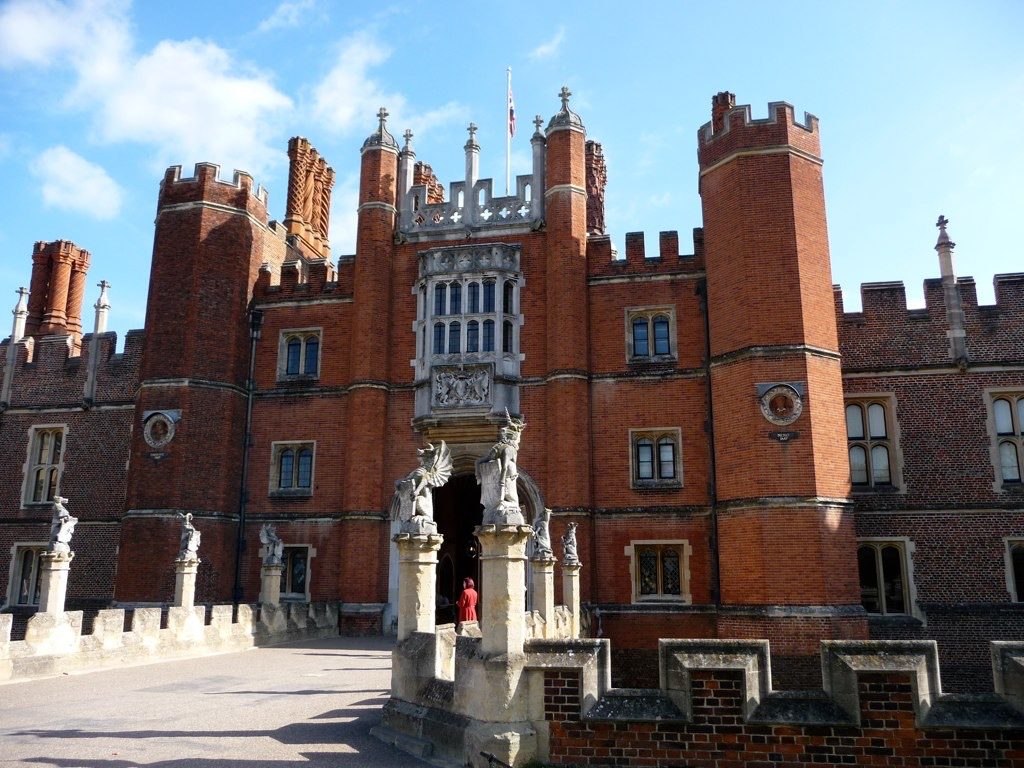
Natalie: I was smiling before you even named it.
Sarah: Yes, I know that it’s one of your personal favourites.
But really, if you want to get up close and personal to Henry VIII, his wives and the court, there is just nowhere like it. Even despite half the palace being Georgianised, I know that’s not a word, that’s just one of my little words there, you know enough remains for any eager time traveller to get an intimate sense of what one of Henry VIII’s great houses really looked like, both above and below stairs. I think you’ll see one of the finest Tudor great halls in existence, and a get a feel for some of the other key spaces in a Tudor palace; like the Great Watching Chamber, the Privy Council room and the Chapel – and that’s even before you get down stairs and you’ve got those amazingly preserved Tudor kitchens, which usually, by the way, have a lovely roaring fire and re-enactors busy doing their Tudor cooking, which is fantastic. And then, you know, the wine cellar and the wonderful complex of corridors that once would have swarmed with the activity of servants keeping the cogs of the everyday court well oiled – I mean it’s just so atmospheric! I suppose my top tip there is if you do see any of the re-enactors around, they are absolutely wonderful. They’ll keep in character and if you choose your own Tudor character you can go up to them and you can really have some fun, so I’d really urge anybody visiting if they do see any reenactors there to go and get in role and really to take up the vibe of the place. So, that’s my first one.
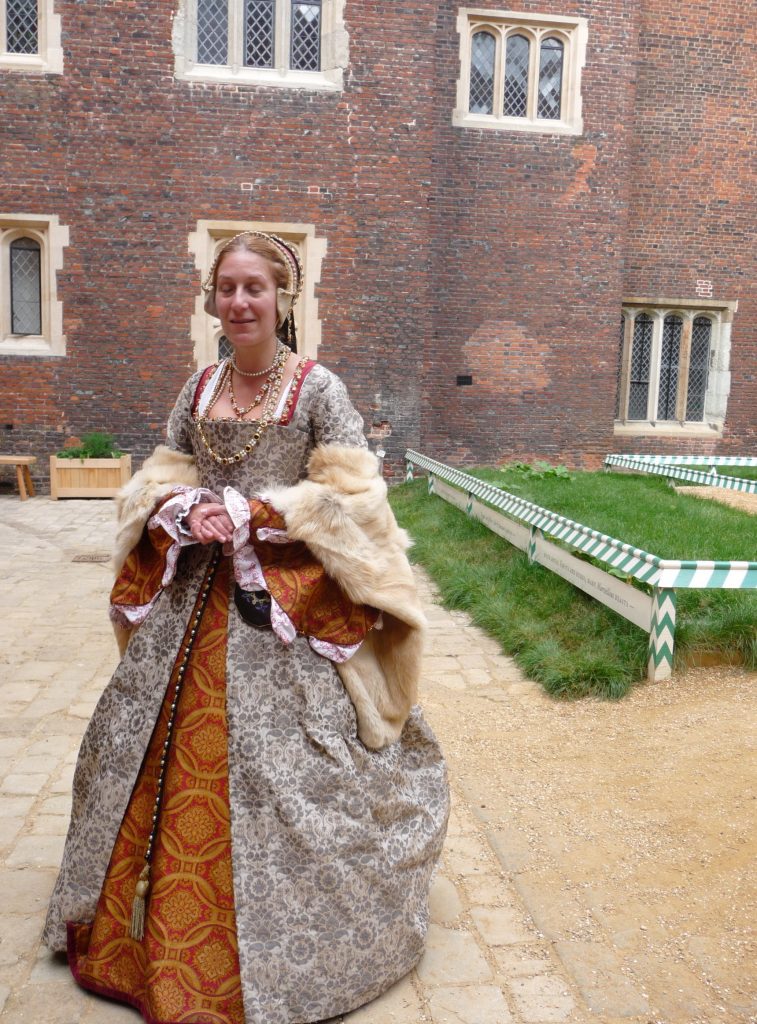
Natalie: Okay, great, started off fantastically.
Sarah: Now we’re still staying in the London area for the second one and that’s Westminster Hall. I specifically say hall and not the abbey because it took me too many years to even realise, I’m ashamed to say, that Westminster Hall actually existed – I was so focused on the Abbey!
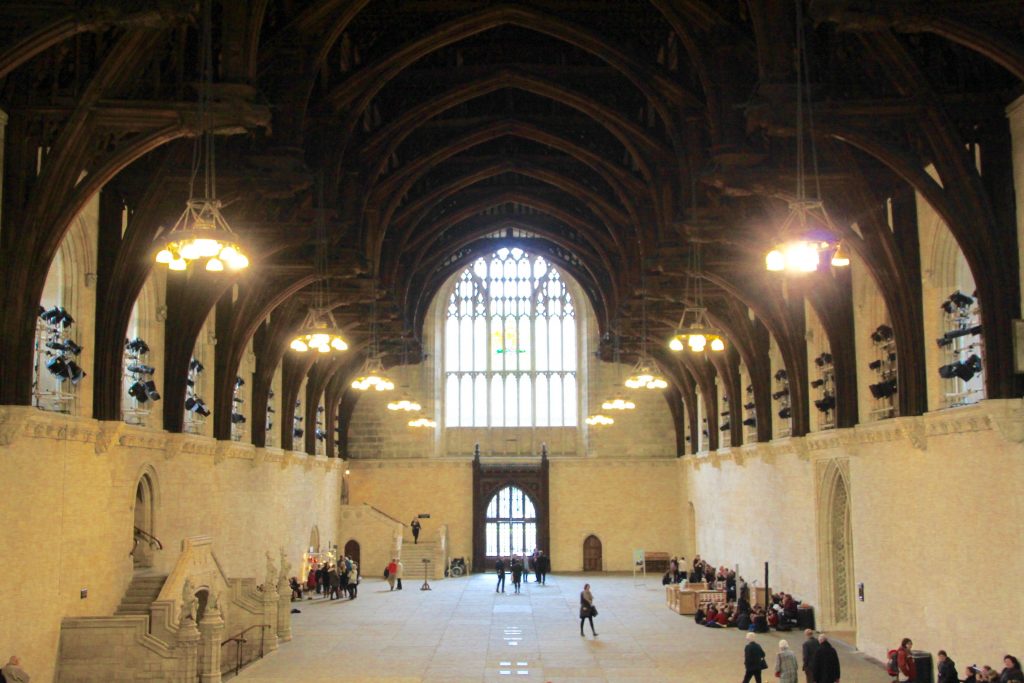
It’s got the largest hammerbeam roof in the country and it’s completely breath-taking. I just remember walking in those double doors at the end for the first time and just feeling completely dwarfed. It was one of those jaw-dropping, completely ‘wow’ moments!
Other than just the building itself, it’s the historical significance of the place. I mean, Westminster Hall has just stood witness to so many key moments in Tudor history. You know we’ve got the coronation reception of Anne Boleyn and the trials of Sir Thomas More and the men accused along with Anne Boleyn in May 1536. You can actually, if I remember rightly, there’s a plaque on the floor for Sir Thomas More’s trial – here stood Sir Thomas More. You go and stand there and you can imagine the stands on either side and the noise and just how intimidating it must have been. It really gives you a lump in your throat. That’s my second recommendation.
Natalie: Love it!
Sarah: And then of course, how could I as a faithful servant and lover of Anne Boleyn not talk about Hever Castle. It was impossible, wasn’t it?
Hever Castle is just nestled in the lovely Eden Valley in Kent, it is just so picturesque and if you do love Anne Boleyn, it is just the must go to place. We talked earlier about ‘vibe’, well for me Hever just oozes vibe. Can sometimes get a little bit busy in the height of the tourist season but if you do what we did, Nat…
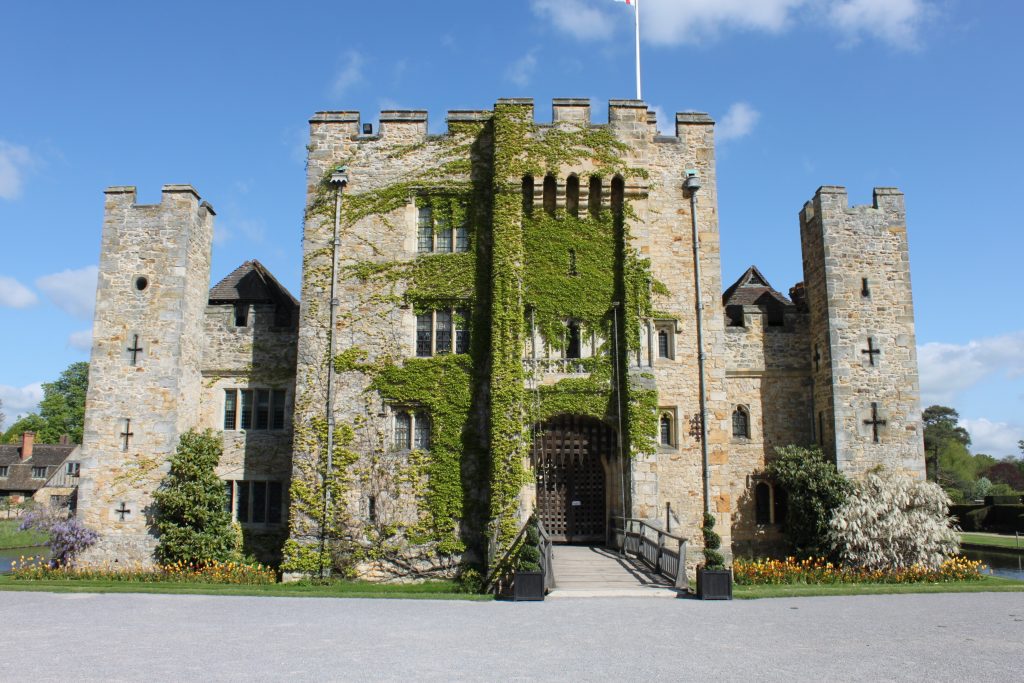
Natalie: I’m laughing just thinking whether we should share our little story?
Sarah: Why don’t you share our story for a moment?
Natalie: Okay, look I’m going to interrupt just briefly to share briefly… I think Sarah and I could do a podcast series just about the funny things that have happened to us while researching places. So we were visiting Hever Castle on year and we know that it can get extremely busy and it is difficult to feel that vibe when there are literally hundreds of people around you, so we thought why don’t we book a private tour – let’s go all out. Just the two of us in the castle and the tour guide, we just loved that idea. So we went ahead and booked the private tour and we made our time and we arrive and were so excited and when we turned up the lady that met us had quite an odd look on her face. Wouldn’t you say, Sarah?
Sarah: Yes, very.
Natalie: She said hello ladies and we said we’re here for the private tour of Hever Castle and she said but where are the tour busses? Instead of expecting just Sarah and I, they thought that we were in fact two tour busses, rather than just two crazy individuals booking a private tour of the castle. So, we laughed, oh my goodness we laughed a lot. We still laugh and that was years ago. It’s just one of the many funny things that have happened to us on our historical adventures but I’ll pass back to you, Sarah.
Sarah: I will say though, I just recently enquired with Hever and the tour prices are still quite manageable. I think it’s about 40 pounds per person, again that’s a top tip for visiting Hever. If you want to go and really get the vibe on your own, without the crowds book yourself in for a private tour. They run before the castle opens, I think before 11 o’clock. That’s a bit of a detour there.
Natalie: I like that. That’s a great tip – thank you.
Sarah: So, obviously Hever is iconically the childhood home of Anne Boleny. The castle was almost completely renovated by the Astor family in the late 19th and early 20th century, but it still retains such a lovely, warm feeling and it’s got such a wonderful energy that just whispers to you of the Boleyn family coming and going, doing their ordinary business – and of course, of the not so ordinary, the King arriving through the gatehouse and into the cobbled courtyard in pursuit of Mistress Anne. Apart from the fact that it’s so iconcially associated with Anne, for me Hever does hold a very special place because it was actually, after one of my visits – I was there with my friend in August 2010 and I was experiencing this very vibe that I talk about and afterwards we went and had a picnic on the lawn and I just got this idea for a 21st century woman who is passionate about history and Anne Boleyn being drawn back in time and into the body of Anne and experiences Anne’s life unfolding through her kind of 21st century eyes. And LTV or Le Temps Viendra was born. Hever Castle has very special memories for me. Apart from that, it’s just a wonderful place to visit. So that’s my third one.
And actually, we’re still on Anne Boleyn for my fourth one but we’re hopping across the channel. We’re travelling to France.
Natalie: Excellent!
Sarah: As you well know, I had the privilege of researching the French locations for In the Footsteps of Anne Boleyn and I travelled to Paris and the Loire Valley to do so. All of the locations are interesting but I would pick the Chateau d’Amboise in the Loire Valley as my fourth recommendation. It’s a beautiful, beautiful place.
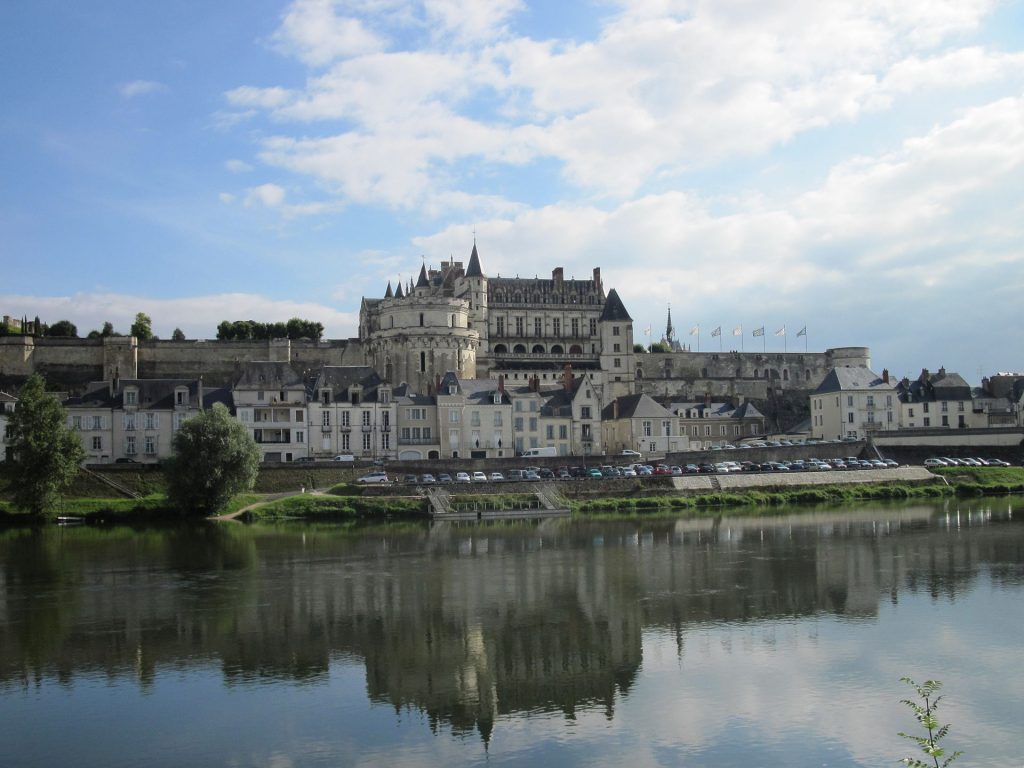
Sadly, the original palace, which is actually situated high up on a plateau overlooking the Loire River is much reduced. Only about 20% of the original complex stands. However, we’re quite lucky in that the wing that does stand, basically contains the French equivalent of the great hall and the public and private chambers of Francis I and his queen, Claude. The king’s chambers, which are on the ground floor are kitted out in renaissance style, so you really get a feel for what the privy royal chambers would have looked like during Anne’s time. You can imagine the teenage Anne there in attendance on Queen Claude and you start to get a real feel for the environment in which she was brought up, so what struck me was just how different the interiors are, so I’m thinking in particular of Hampton Court. It feels quite heavy and dark, with all these dark oak interiors but in the chateau of the Loire it’s very light. It’s beautiful light coloured stone and all the windows are thrown open and there’s this beautiful warm breeze during the summer.There was such joie de vivre about the place and I just began to understand why Anne might have had such fond memories of her time there.
And then you can put into context some of the important people, who surrounded Anne during those formative years, such as the indomitable Louise of Savoy and the future Margaret of Navarre – and the great renaissance minds like Leonardo da Vinci, who happens to be buried in the chapel actually.
Natalie: Oh, how wonderful!
Sarah: It’s a lovely kind of bonus. (Laughing)
Once I’d visited those places, it was really the first time that I felt that I had a good understanding of the forces that shaped Anne Boleyn’s character and her tastes in religion, books, music etc. So, if you are really a keen Anne Boleyn fan, it’s fascinating to explore the Loire Valley. I would highly recommend that.
So, I’m on my fifth one and we’re back here in the UK for that and this is actually Haddon Hall.
Natalie: Oh, I love Haddon Hall! It’s one of my favourites too.
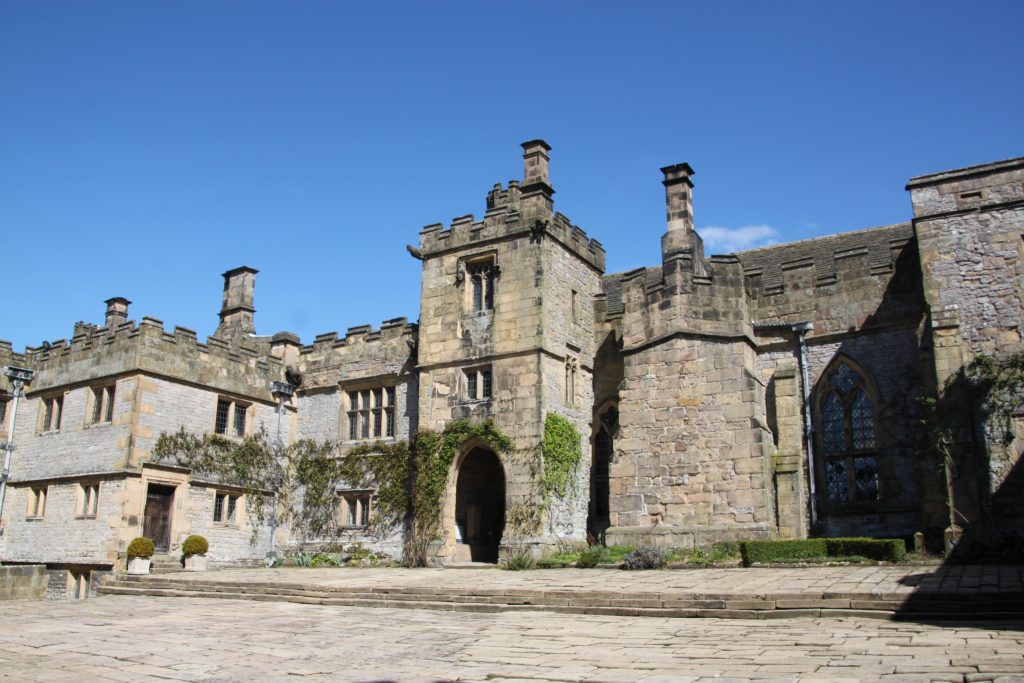
Sarah: I know you love it and I love it because I think that Haddon is actually an example of a fairly perfectly preserved medieval/Tudor home in miniature. When you visit it, if you’re interested in the architecture and the structure and the way the rooms are laid out, you get to see the features of a fashionable Tudor house of its day. You’ve got the central courtyard, that leads, via a porch into this beautifully warm great hall and I think when were there, the fire was lit.
Natalie: It was. It was beautiful.
Sarah: It really brings the room to life. At Haddon you see the true arrangement of how an original hall would be, so you have the screen at the lower with the corridor, leading down into the medieval kitchens, which are really amazingly well preserved. I’m not usually that interested in the below the stairs stuff but I really enjoyed looking around the kitchens at Haddon. Then at the high end, you’ve got this access to a parlour and the staircase going up to the privy chambers, which is kind of – that’s where the lord and lady would retire after dining at the high end of the hall and so you get to see how that arrangement would be. And over and above that, it’s just got beautiful interiors, amazing panelled rooms and then in my opinion, Haddon has one of the finest and most pleasing long galleries in England.
Natalie: Oh, it’s absolutely outstanding.

Sarah: It really is, isn’t it? I was really shocked by how beautiful it was when I first saw it and I kind of found it hard to tear myself away!
Natalie: It’s true! I know, I think I took I don’t know how many videos and about a hundred photos, which I’ll share later. I’ll put some on the blog so people can see, and sorry to interrupt you but Haddon also has the most beautiful chapel.
Sarah: Oh yes, it does. I hadn’t mentioned the chapel but there’s lots of original medieval stuff in there, isn’t there?

Natalie: I felt really, like, you know we’ve been talking about the vibe, I felt a very strong vibe in there. I think you’d left to go and do something and so I was just in there on my own and I could really picture a Tudor person coming in and going to prayer. It was just, oh, just so beautiful.
Sarah: Hmm, yeah. I think the reason why I’ve picked Haddon is because the Tudor time traveller has got a lot to learn from the hall about that layout of a grand Tudor house and some of the genuine interiors. Highly recommended and that’s in Derbyshire, of course.
Natalie: I love your 5, Sarah. Your 5 are fantastic.
Sarah: Oh, I could have gone on forever. It could have been twenty or thirty. Let’s draw a line under that.
Natalie: I wanted to talk to you about some of the key features because in our research we very quickly discovered that in the houses and the palaces there were certain key features that we found in all of these grand stately homes and palaces. You’ve touched on some already, did you want to add anything to that about the key features?
Sarah: There’s certainly more that we can say about that. Before I dive in and maybe explain what some of those key features are, I’d like to say just a couple of words about why I think it’s interesting. I remember before I started researching and writing for our books, I’d go to these places and I’d get a guide book and I’d wander around and I’d enjoy the rooms, for sure, but it was all quite superficial. I didn’t really know what I was looking at. I couldn’t really ‘read’ the building.
Having now researched and written about a lot of Tudor buildings what you begin to realise is that any aristocratic house of the period conforms to a certain pattern and when you understand that pattern, you can ‘see’ more and I emphasise the word ‘see’ more. Particularly if the house is what I called ‘messed around with’ by later generations of owners, and you’re interested in getting a feel for how it would have looked originally, you can then start to see things and interpret things and make sense of how those rooms would have originally been configured and used. So that’s why I think it’s really interesting and useful.
In terms of me describing some of these key features, you have to bear in mind that the actual number of the rooms would vary depending on the size and importance of the house, so the larger aristocratic houses, palaces, Henry’s palaces, obviously would have many more rooms than a smaller manor house but nevertheless you can still strip down to sort of a basic structure and that’s what I’ll focus on and I’ll maybe focus on somewhere like Hampton Court or one of Henry’s palaces that I wrote about in a recent blog, to just maybe describe some of those key features.
You would usually enter in through a Great Hall. Halls always had a lower end, which was the service end of the hall and there was usually a screen, which made this kind of passage called a Screens Passage and that screened off the hall usually from three doorways that would lead – usually the central one to the kitchen, and then the pantry and buttery on either side. By the way, I’m sure some of your listeners already know this but I will confess my ignorance. I actually thought a buttery was where they kept butter! (Laughing)
Natalie: It sounds like it! I don’t know why they need to confuse us.
Sarah: But it’s actually where they kept the butts of wine, so there you go. You live and learn all the time.
These three doorways that I was talking about have unfortunately in a lot of been lost over time, so you might not see those. I was there at Penshurst Place last weekend, and the kitchens, buttery and pantry had actually been swept away completely, although they’d managed to preserve the three doorways but even that is sometimes lost. So that’s the lower end of the hall, at the upper end of the hall, you’ll often find a little raised stone platform called the dais which is where the lord, the king, the queen, the lady and his family would have sat and dined. In the largest of palaces, like Henry’s palaces, that would then lead through into another large room the great watching chamber. So, we can think Hampton Court here, where the great wathching chamber still survives. Here, literally, guards would watch over the king or queen depending on which ‘side’ of the palace you were on, so it’s important to say whatever was going on on the king’s side, was usually replicated in the same set of rooms and lodgings on the queen’s side. You hence had the queen’s side and the king’s side.
The great watching chamber was sometimes used for ceremonies and events but mostly these would take a in the next chamber, which was directly adjoined to it, called the Presence chamber.
Usually you would have two guards standing at the presence chamber, and where as pretty much anyone could get into a great hall or a great watching chamber, you usually had to be of a certain status to be allowed entry into the presence chamber. The Presence chamber was the last public chamber of the palace. Largely, you would see the throne sitting under a canopy of estate, usually with a carpet on the floor and nobody was allowed, except the king or the queen, to be under that canopy of estate or to step onto that carpet. The use of the room was usually around public ceremonies or audiences and sometimes dining but as I said this was the last public space. Beyond that, particularly in the early years of Henry’s reign, it did change a little later on in his reign, it was the last public room before entering the king’s private chambers and what you would usually find is a short corridor that acted like an airlock, a physical break between the king’s public and private life.
Beyond that there would be the privy chamber, in my mind is a bit like our modern-day lounge; a place to relax, meet with honoured guests, I could imagine them in the evening playing cards or dice and listening to music etc.
Remember of course, Nat, that as we go through these rooms they’re getting smaller and smaller and progressively more intimate, with increasing levels of control in terms of who can get access to the king or the queen.
Beyond the privy chamber, in the largest palaces, there may have been another withdrawing chamber but let’s just stick to, there being the bedchamber. Again, in some very large houses, there was almost like a state bedchamber where there’d be a bed of state. For example, I think Windsor Castle had that arrangement during Henry VIII’s reign. The king didn’t sleep there, though, there was then a second bedroom that led on from that and that would be where the king actually slept. Maybe just one more thing to add about kind of the common arrangement of rooms is that very often, I talked before about there being a king and a queen’s side, and very often these two sides would meet at the private end of the chambers. There would even be a connecting bedroom or a gallery that would connect the king and queen’s private apartments, so the king could visit his wife with a certain degree of privacy, without the whole court knowing about it.
The only thing to say really is that smaller houses had the same kind of configuration but for example, we might move from the great hall directly into the solar or withdrawing room, rather than there being a great watching chamber or a presence chamber, so in other words you would be missing some of the great ceremonial rooms that you find in Henry’s larger properties. You can see it varies a bit but there’s a basic template and once you’ve got the basic template, you can start to work it out for yourself and it certainly increased my enjoyment of visiting places.
Natalie: Absolutely, it’s so important, isn’t it? What also just popped into my head, something that we discovered quite quickly is that early on in Henry’s reign, the king’s and queen’s apartments tended to be stacked and then that became old-fashioned, they thought that it yesterday’s look, now we’re going for the apartments on the same level and meeting, as you just said.
Sarah: That’s a good point and Hampton Court is great for that. The original wing, Wolsey’s palace were stacked and then of course, when Henry redeveloped them for Anne Boleyn, he ended up doing the modern version.
Natalie: Fantastic! Thank you so much. That was great. Now, I wanted you to talk to me a little about the Tudor royal interior. You’ve touched on the chateaux in the Loire and what that felt like. What were the Tudor royal interiors like in these stately homes, palaces and castles?
Sarah: Very opulent and probably a little bit gaudy by the standard of our tastes today. A real clash of colours, a riot of colours. Let’s have a think about that. In terms of the floors, they might be tiled. I was just mentioning that I was at Penshurst Place last week and their great hall is covered in 16th century terracotta tiles – which are wearing pretty well, so they’re obviously pretty durable. But in the more high-status rooms, you would probably get coloured tiles and I know that… I think it’s the picture of the family of Henry VIII, which was supposedly painted with a back drop of Henry VIII’s presence chamber in Whitehall, you can see these very brightly coloured tiles on the floor. If not that, wooden floors, but often the floors were covered in rushes, of course that were scented. I suppose this was a way of keeping the floors as clean as possible and making the cleaning of the buildings more easy and covering some of those more distasteful smells that were associated with Tudor palaces. Maybe we won’t say much more about that… There was a lot of oak panelling or linenfold panelling. A lot of the rooms would be panelled if not also hung with tapestries. Of course the tapestries themselves were hugely expensive, so you’d only have the riches folk in the kingdom being able to afford those, particularly those that had been spun with gold or silver thread.

I mentioned carpets earlier, their carpets were also hugely expensive and they were actually often displayed on tables or sideboards and not placed on the floor at all, with the exception perhaps, as I’ve noted, in the presence chamber under the canopy of estate.
In terms of some of the decoration, it was obviously of a particular style. The renaissance saw the flourishing of the so-called grotesque style, with patterns that related back to ancient Roman and Greek cultures. Geometric patterns were also common, and so you’d find those carved into wooden panelling or into the ceilings and often they would be greatly gilded, so there would be a lot of gilding of that panelling. Again, if you do look the family of Henry VIII portrait, you can see the riot of colours and the amount of gilding that has gone on the walls, pillars and ceiling.
Natalie: Yes, I often wonder… I don’t know that I would have liked Tudor interiors very much. My taste these days is quite muted colours and that’s definitely not what you got in the Tudor palaces.
Sarah: It’s all very shabby chic, French, country cottage! (Laughing)
Natalie: Exactly, I love that! Now, something that you and I have written quite a lot about is the Tudor royal progress. We both absolutely love these progresses. They were quite magnificent. Can you tell us a little about this annual event?
Sarah: Yes, so, the royal progress. We have had a good time writing about progresses, haven’t we? Particularly, we wrote about the 1535 royal progress of Anne Boleyn and Henry VIII for In the Footsteps, which was great fun and really informative, actually. Being able to follow the court from place to place, it really built up a picture, which I found fascinating.
The annual progress took place regularly during the summer months. Perhaps the only thing that would stop it might be war, illness or pregnancy. Not the king. Obviously… There is an example of the latter in 1533, when Anne was heavily pregnant during the summer months. She remained at Windsor while the king went off and only did a mini progress through some of the home counties around London.
Progress took place for a number of reasons: of course, it allowed the king and court to escape, disease, plague, which might most likely flare up in London during the hot, summer months, and we mentioned smelly palaces, it also gave plenty of opportunity for all those principal houses along the Thames, which were used during the rest of year to be thoroughly cleaned. From a propaganda point of view, the progress allowed the king or queen to be seen by their subjects and finally, I think this comes through loud and clear when you start researching any progress, the progresses were definitely for pleasure. There was copious opportunity for hunting and hawking, amongst some of the finest parks in the country and of course, much, much time was given over to general merriment. I know you and I were regularly unearthing entries in the Letters and Paper of Henry VIII saying that the king and queen were ‘merry’, usually in Hampshire, so there you go.
Natalie: That’s right, that’s the place to be Hampshire. If you want to be merry, visit Hampshire.
Sarah: So, the itinerary was usually published in advance of the progress and as we found out in our research it could head off in a number of different directions. Sometimes it went south through the southern home counties and then other times, perhaps more commonly during the periods we were researching, up north towards Oxfordshire and Northamptonshire, probably with a couple of notable exceptions like the 1540 progress to York or the 1535 reformation progress, when they headed north Grafton was often the most northerly point of progress for the court.
Along the way, the court visited many of the king’s properties, but they also lodged with favoured courtiers and that was certainly true during the Reformation progress, when we saw the supporters of Anne Boleyn and the reform courted along the way. The likes of Sir Nicolas Poyntz at Acton Court and Sir John and Lady Anne Walshe at Little Sodbury Manor, incidentally, aunt and uncle to Sir Nicolas. Abbeys and priories were another favoured destination, where they king and queen would be lodged in the Abbots lodgings, the highest status chambers in the building. Of course, this was before the Dissolution of the Monasteries. Thereafter Henry had a problem because some of these places that he’d grown used to lodging in were obviously dissolved but Henry’s solution was to requisition some of them, like he did at Rochester, Dartford and York, and preserve at least part of the abbey, usually the Abbot’s Lodging, into what often became known as the ‘King’s Manor’ and therefore was able to be used thereafter. So that’s a bit about progresses but you know, I wonder, Nat whether since we’ve enjoyed writing about progresses so much, whether now might be the time to make our little announcement.
Natalie: I think so. I’m going to let you do this one, Sarah.
Sarah: Alright, so this is a world exclusive, folks. This is just really to say that Nat and I love writing together so much, we want our mutual love affair to continue, so we’re already collaborating on our next book, which is going to be called ‘On Progress with the Tudors’ and will chart some of the most interesting and significant journeys of the Tudor era in full and it will span the entire Tudor era. We’ll be picking out some of our favourites and whilst that’s one announcement, we also have another announcement! In relation to that what we want to do is to launch a podcast series. This podcast series will be created by me as The Tudor Travel Guide and will be called ‘On Progress with the Tudors – Uncut’ and the uncut bit is that we’re actually going to be sharing with you, good listeners, the progress of our researching and writing of the book as it goes along. We’re already underway and what we’re going to be doing shortly, is putting together the first episode of that series of podcasts and we’ll be carrying on through the progress of writing the book, so you will literally, listen as the book takes shape and as we, ie. Nat and I, share and debate what we’re uncovering as we go along in our research and hey, who knows Nat, might be even opportunity for our listeners to get involved in the process.
Natalie: I’d love that, an interactive element to the podcast and to the book would be fantastic because we know how knowledgeable our readers and our listeners are. I think it’s going to be a really exciting venture and I’m really looking forward to it.
Sarah: Yes, vive la podcast!
Natalie: Now, let’s move on Sarah and talk about lost Tudor palaces. Here I go again, I’m going to tell another story because I just can’t help it. Do you remember the day that we went in search of the site of Nonsuch Palace?
Sarah: How could I forget! I laughed a lot.
Natalie: When we arrived at the park where the palace once stood, there was a group of men, I don’t know if there was something on, but there was a group of elderly men gathered there and we asked one of the men for directions to Nonsuch. He obviously noted the enthusiasm in our voices and responded with a somewhat quizzical look on his face and said, “You do realise it’s gone?” And then kind of just stared at us. We just had a bit of a giggle because anyone that knows Sarah and I knows that we love standing in empty fields. It’s actually what we do. It’s part of the job and we just like to imagine what once went on there. Now, talking about Tudor palaces, if you could bring back one of the lost Tudor palaces, which would it be and why?
Sarah: This is actually quite easy for me to answer. It’s Greenwich Palace. Without a doubt and I’ll tell you why. When I was writing LTV, I spent so much time in my mind’s eye in Greenwich that I think I could walk you round it now if it was recreated and be a tour guide. I feel like I know the rooms so intimately and to see them brought to life would be just incredible. It almost feels like home and one of my favourite chapters in the whole book is based at Greenwich, the one describing Sunday 30th April, when Anne knows she is fighting for her future and for her life. It was a really emotional chapter to write and just to be able to go back, I’ve actually almost got a tear in my eye just thinking about it, that would just be amazing. The other place I’d like to go… Greenwich had in the king’s apartments which fronted onto the river there was a tower, the Donjon, and it had three or four floors and one of the upper floors had the king’s privy library in it. Libraries at the time were incredibly rare and I would just love to climb that staircase and just have a look around at Henry VIII’s private library. Gosh, it gives me shivers just thinking about it. And can you imagine standing in the queen’s presence chamber, where Anne Boleyn was arrested, the place where she had her last meal in freedom under her canopy of estate before being taken to the Tower! The events that have taken place there, the birth of Henry VIII and Elizabeth I, the arrest of Anne Boleyn and marriage of Anne of Cleves, I mean it just goes on and on. So, from a historical perspective, I think Greenwich – Team Greenwich, that’s me.
Natalie: Now before we wrap up here, I think people have gotten the idea that you and I could talk forever, three hours later and we could still be here, so before we wrap up, I’d like you to tell us a little about this new venture, The Tudor Travel Guide. I love the name and I love the idea behind it, so maybe if you just tell us a little bit about that.
Sarah: Yes, okay. Really, I suppose, it’s drawing on a number of loves of mine; my love of the Tudor era, and of places in particular, my love of writing, and finally, my love of sharing all this with others, it seemed a natural step to build on all the research and writing I have done to date, bring all these passions together and create a blog which is dedicated to being ‘your intimate guide to discovering the castles, palaces and manors of Tudor England’.
I know that in the past… one of my motivations for doing this, I have visited somewhere and I’ve bought the official guide book, it doesn’t really focus in enough depth on the Tudor era. I can’t tell you how many times I’ve been somewhere and have later found out about an object or artefact or something I should have seen which has enormous relevance to the Tudor story, and I have completely missed it! Well, my aim is that my fellow Tudor time travellers will never again leave a place saying, ‘oh, if only I’d known about!’
The aim is to build up a wealth of knowledge about wonderful, fascinating and charming Tudor places to visit, and look to lift the veil on as many hidden gems as possible, and all the while thinking about how to make the visit as rounded, and interesting. So, it’s a bit like our style in In the Footsteps books, the blog is a bit of a travelogue, bringing in top tips on where to go, what to see, where to stay and where to get the best refreshment. And for those who love donning their walking boots and seeing their history from a different angle there is even a section on the blog about historic walks, which take in different Tudor properties on foot.
Natalie: Fantastic! It’s an incredible resource and I recommend that everyone go and have a look at The Tudor Travel Guide. Sarah, are you ready to play Ten to Go?
Sarah: I’ll give it a go!
Natalie: These are just ten quick question, so don’t take too long and just go for it!
Name two items on your bucket list?
Sarah: One is going to Westminster Abbey’s Jubilee Galleries, which I am going to be doing in about two weeks and another would be to re-enact in costume at Hampton Court Palace.
Natalie: Ooh, who can make that happen? Anyone who’s listening? Okay, what do you do to recharge?
Sarah: Meditate.
Natalie: I’m with you on that one. Earliest childhood memory?
Sarah: Sitting on the loo. (Laughing)
Natalie: Thank you for being honest, that’s what we like here. (Laughing) Name a favourite childhood book.
Sarah: The Magic Faraway Tree by Enid Blyton.
Natalie: I love Enid Blyton. Describe your ideal Saturday night.
Sarah: Oh, at home. I’m a bit of a home bod, I’m afraid. At home just relaxing. My weeks are really busy and so just some downtime at home, pottering around with not too many demands is actually my ideal Saturday night.
Natalie: That sounds good to me as well. What is something most people don’t know about you?
Sarah: Umm, oh gosh.
Natalie: I think I can answer that one, Sarah.
Sarah: Go on, you answer.
Natalie: That you’re actually a medical doctor. You’ve told people now but I don’t think they would have known that beforehand. That’s quite cool, I think.
Sarah: Okay, good one. Thanks for helping.
Natalie: What is your guilty pleasure?
Sarah: Oh, chocolate.
Natalie: Yes, I know you love dark chocolate.
Sarah: Copious quantities of chocolate!
Natalie: What was you first paid job?
Sarah: You know I think it was literally when I started as a doctor. I didn’t do any of the newspaper rounds or stuff like that. I was probably too busy studying.
Natalie: Probably! I was too busy at McDonald’s, working at McDonald’s. (Laughing)
What’s your drink of choice? If someone takes you out for a drink, what are you having?
Sarah: Prosecco.
Natalie: Yummy, and lucky last, your go to karaoke song?
Sarah: Dancing Queen.
Natalie: That’s good, I love that. Now, I ask all my guests this before the conclusion of the episode, what is your Tudor Takeaway? Just to clarify, this is just something that we can all explore after the episode. It might be a link to a website, a great song on YouTube, something that’s going to nurture our love of Tudor history or maybe help us deepen our understanding about something. It can be anything you like.
Sarah: Okay, well I’ve got to do this, haven’t I? I’ve got to say go and see the Anne of Cleves Panels at St Leonard’s Church in Bedfordshire. Whye? Because if you don’t know, during researching ‘In the Footsteps of the Six Wives of Henry VIII’ we “uncovered” or re-established a set of carved oak panels that exist in St Leonard’s Church in Bedfordshire as actually being contemporary to Anne of Cleves. It was thought that they might have been from the sixteenth century or the seventeenth or even the nineteenth century, nobody really knew. But they’re now a nationally important historic collection and the thing is, the reason why they’re significant is that according to Jonathan Foyle, who helped us with the research, they are a really rare survivor of the domestic interiors of any of the royal family of the time and you can actually go along and touch them. They’re not in a museum, they’re right there for you to see and touch and that’s pretty rare, so that’s my Tudor Takeaway.
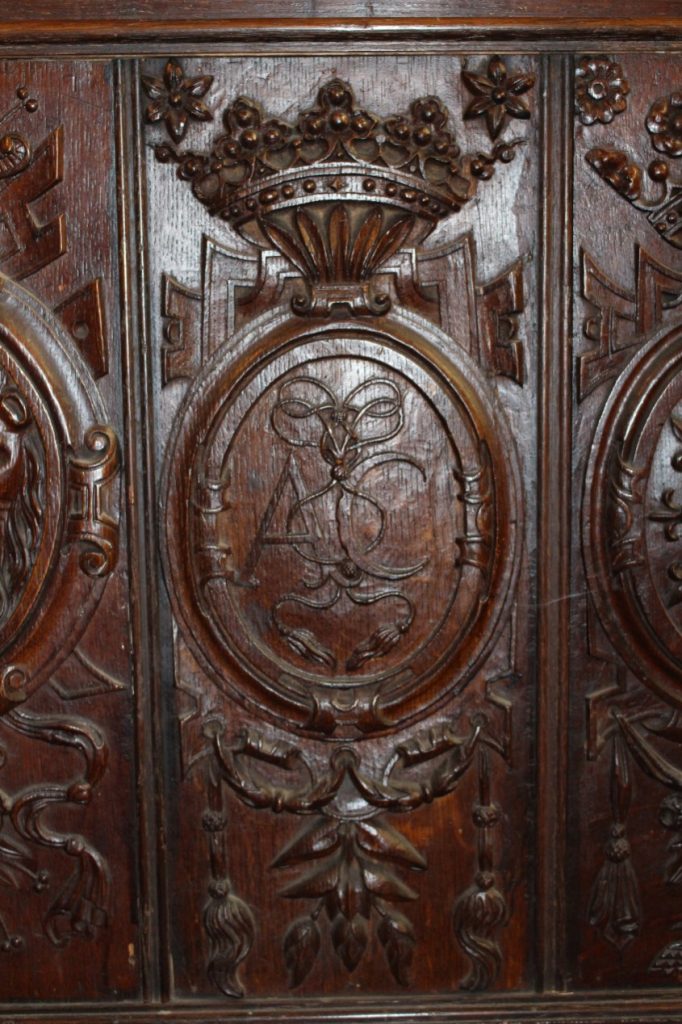
Natalie: What a fantastic takeaway! Thank you so much, Sarah. This has been so much fun. Thank you for joining me on Talking Tudors. This has been such a pleasure and thank you very much.
Sarah: You’re most welcome. I’ve thoroughly enjoyed myself and I hope your listeners have enjoyed this too.
Natalie: Alright, wonderful. Thanks.
Well, that brings us to the end of this episode of Talking Tudors. Thank you so much for listening. If you have any comments or suggestions, or just want to say hi, please get in touch with me via my website www.onthetudortrail.com, where you’ll also find show notes for today’s episode. If you’ve enjoyed the show, please share the podcast with friends and family and click on the all-important follow button, so you’ll never miss an episode. It’s time now for us to re-enter the modern world. As always, I look forward to talking Tudors with you again very soon.
(Music to fade)
Find out more about Sarah Morris, aka The Tudor travel Guide, online via the following:
Blog: www.thetudortravelguide.com
Twitter: @TheTTGuide
Facebook: www.facebook.com/thetudortravelguide
Instagram: thetudortravelguide
You Tube Channel: The Tudor travel Guide
PS. from Sarah!
In early August I will be launching the first in a series of brochures called, “A Weekend Away With The Tudor Travel Guide’. Each brochure will focus on one county and give you an in-depth guide to 3 places, an historic walk, taking in one or more of the properties and two accommodation suggestions; one luxury and one luxury for less. They will be personal recommendations as I visit every place I recommend. There’s also a little itinerary included too, so you really just have to find time in your diary – all the hard work has been done for you. The first brochure will be a free giveaway for anyone who has signed up to my blog.


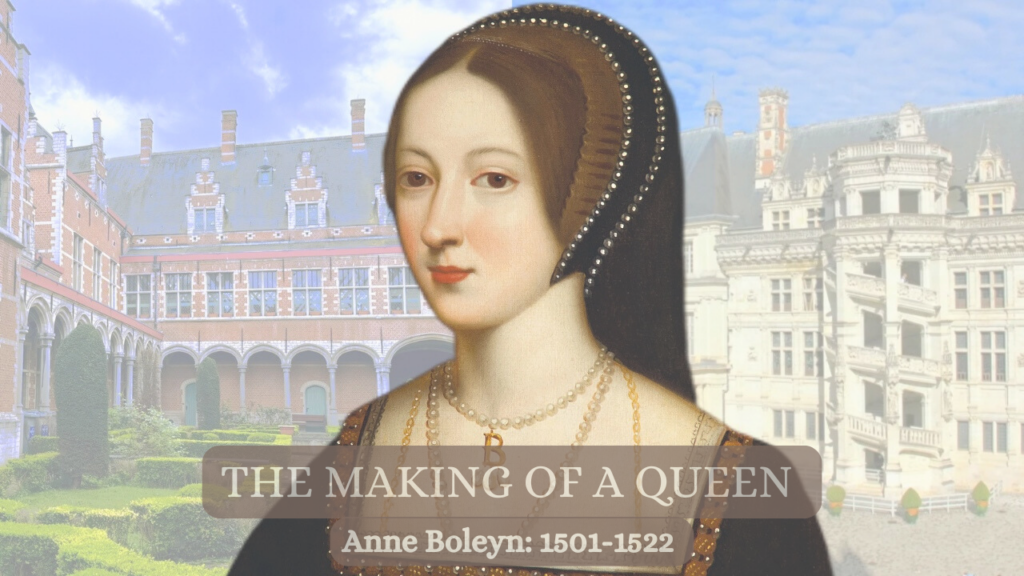














I love this podcast so far! I listened to you and Sarah Morris and I felt like I had traveled with you! Your description of Haddon Hall is spectacular and refreshed so many memories when my sister and I happened upon this gem! I specifically loved your “connection” to places and how they made you feel. What a wonderful podcast and I can’t wait to hear more. Thank you!
Kathleen, Stow, Ohio
Thank you for your lovely message, Kathleen! Lots more episodes on the way. 🙂